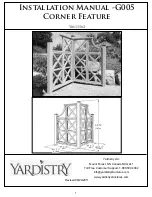
Safety
MTS Landmark™ Tabletop Load Units - Product Information
19
Know compressed gas hazards
Your system may contain accumulators that require a high-pressure gas precharge (pressures that
exceed 138 bar [2000 psi]). High-pressure devices are potentially dangerous because a great amount
of energy is available in the event of an uncontrolled expansion or rupture.
Observe the following safety practices when you work with high-pressure air or gases:
l
When you charge an accumulator, follow all the charging instructions provided in the
appropriate product information manuals. When precharging accumulators, properly identify
the type of gas to be used and the type of accumulator to be precharged.
l
Use only dry-pumped nitrogen to precharge nitrogen-charged accumulators. (Dry-pumped
nitrogen can also be labeled “oil pumped” or “dry water pumped.”) Do not use compressed air
or oxygen for precharging: the temperature increase caused by rapid gas compression can
result in highly explosive conditions when hydraulic fluid is in the presence of oxygen or
compressed air.
l
Always follow the recommended bleeding procedures before you remove or disassemble
components that contain pressurized gas. When you bleed a gas or remove a fitting, hose, or
component that contains a gas, remember that many gases cannot support life. Therefore, as
the ratio of released gas to oxygen increases, so does the potential for suffocation.
l
Wear appropriate safety devices to protect your hearing. Escaping air or gas can create a
noise level that can damage your hearing.
l
Ensure that all pressurized air or gas is bled out of a pneumatic or gas-charged device before
you start to disassemble it. A thorough understanding of the assembly and its pressurized
areas is necessary before you undertake any maintenance.
It may not be obvious or intuitive which bolts or fittings are used to restrain a pressurized area.
On some assemblies, you must remove a cover plate to gain access to the structural bolts.
Sometimes, to protect you from a rapid release of trapped gases, a small port is exposed
when you remove this cover plate. Exposing this port ensures that the gas precharge is fully
bled before disassembly. However, this is not the recommended procedure for bleeding a
pneumatic or gas-charged device, because it can expose you to the dangers of escaping
compressed gas and particulates that are expelled from the chamber or around the seals. Do
not assume that cover plates and ports are installed in all the critical locations.
Consult MTS when in doubt about the safety or reliability of any system-related procedure or
modification that involves devices that contain any type of compressed gas.
Check bolt ratings and torques
To ensure a reliable product, fasteners (such as bolts and tie rods) used in MTS-manufactured
systems are torqued to specific requirements. If a fastener is loosened or the configuration of a
component within the system is modified, see the system and component assembly drawings (located
on the System Documentation CD) to determine the correct fastener, fastener rating, and torque. Over
torquing or under torquing a fastener can create a hazardous situation due to the high forces and
pressures present in MTS test systems.
















































